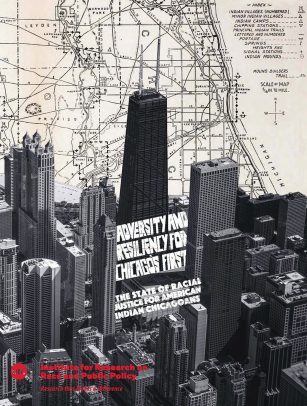New UIC report on racial inequity for Native Americans in Chicago
Did you know Chicago is one of the country’s primary population centers for Native Americans?
The city is home to the largest population of Native Americans in the Midwest, the second largest east of the Mississippi River, and the ninth largest in the U.S.
Despite the 39,000 Native Americans representing more than 100 tribes living in Cook County, they are generally considered as “historical figures” or confined to reservations, according to researchers from the University of Illinois at Chicago’s Institute for Research on Race and Public Policy.
Their new report, “Adversity and Resiliency for Chicago’s First: The State of Racial Justice for American Indian Chicagoans,” documents the historical and ongoing contributions of Native Americans in Chicago and examines how racial inequity impacts members of this community today.
“The contemporary challenges faced by this population are deeply connected to the past and impossible to understand without acknowledging the history of Native American exclusion and the ongoing barriers created by systems of racial discrimination,” said William Scarborough, report co-author and research assistant at the institute. “By making these inequities visible, we hope to inform future pursuits aimed at addressing racial injustice in Chicago.”
Top findings in six key areas in the report include:
Population
- Today, Native Americans in the U.S. are just as likely to live in urban spaces as the general population.
Housing
- The Brighton Park and Lakeview neighborhoods are home to the city’s largest segments of Native Americans.
- Half of Native Americans in Chicago are rent-burdened — paying more than 30% of their income in rent.
- Researchers find evidence of housing discrimination toward Native Americans, who are almost twice as likely to be denied a home loan as whites after accounting for the gender of the applicant, presence of a co-applicant, loan amount, income and neighborhood.
(Mis)Representations of American Indians in Popular Culture
- When Native Americans are depicted in U.S. culture, they are most often represented as historical figures from the “long ago past,” thereby overlooking their importance as active members of contemporary U.S. society and contributors to it.
- Native American imagery in sports mascots or team names fosters negative cultural biases about Native Americans that increases discrimination against them by other groups and has harmful effects for Native American health and self-identity.
Education
- Native Americans are less likely than whites to have a college degree.
- The wage increase associated with a college degree is lower for Native Americans than for all other race groups in Chicago.
- The analysis suggests test preparation and college readiness are areas for the Chicago Public Schools to place greater attention to support more than 1,000 Native Americans enrolled in the system.
Economics
- Native Americans in Chicago have higher levels of unemployment and lower median household income than whites in the city.
- Native Americans are paid 20% less than similarly positioned whites in Chicago, which is similar to the racial wage gap for black residents and larger than that experienced by Latino and Asian American residents.
Justice
- The adult incarceration rate in Illinois is much higher for Native Americans than for whites.
- Rates of incarceration for women in Illinois are higher for Native American women than for women in all other racial/ethnic groups.
The report also includes commentaries written by Native American community leaders and scholars, who further examine these matters and the efforts being made to overcome these barriers.
Those providing commentary include Janeen Comenote, executive director of the National Urban Indian Family Coalition, who provides a demographic overview of urban American Indians and Alaska Natives and discusses government policies influencing these demographic shifts and subsequent community responses.
Jasmine Gurneau, manager of Native American and Indigenous Initiatives at Northwestern University, focuses on the process of data collection and determining who “counts” as Native American.
Shelly Tucciarelli, executive director for Visionary Ventures NFP, and Pamala Silas, associate director for the Center for Native American and Indigenous Research at Northwestern University, deliver co-authored commentary focused on where Native people are living in Chicago and the social and housing issues they face in the current housing market.
Cynthia Soto, director of the Native American Support Program at UIC, writes about benefits of university programs that are established to both serve the unique backgrounds and experiences of Native American students, as well as to educate the campus community on the history and culture Native American people.
Expert commentary from Angela Lecia Walden, research assistant professor for the Center for Dissemination and Implementation Science and clinical assistant professor at the department of psychiatry’s Institute for Juvenile Research at UIC, examines the impact of pervasive stereotypes on Native American health outcomes.
“It is our hope that the research presented here will contribute to broader efforts taking place to transform our city into a more equitable environment for all residents,” said Amanda Lewis, director of the Institute for Research on Race and Public Policy and professor of African American studies and sociology.
Additional co-authors on the report are Faith R. Kares, associate director of the institute; and Iván Arenas, associate director for community partnerships in the institute.
The new report, which was supported by funding from the Spencer Foundation, is the latest in a series from the Institute for Research on Race and Public Policy that explores racial justice in Chicago. Its 2017 report, “A Tale of Three Cities: The State of Racial Justice in Chicago,” detailed the divergent conditions for blacks, Latinos and whites in the intersecting domains of housing, economics, education, justice and health. “A Tale of Diversity, Disparity, and Discrimination: The State of Racial Justice for Asian American Chicagoans,” which highlights major demographic changes in Chicago’s Asian-American community, was released in April 2018.

